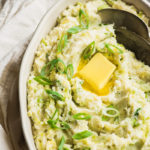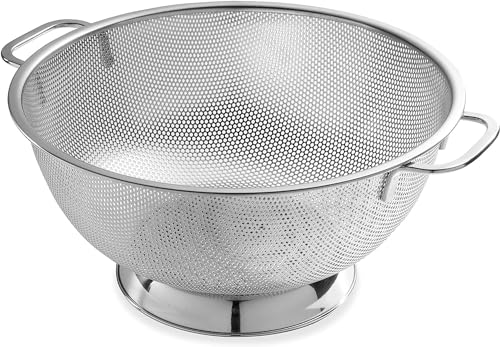 Buy Now →
Buy Now → Parsnip Colcannon with Cabbage & Leeks
This fluffy parsnip Colcannon is a fun, nightshade free take on the classic recipe. Here, it’s lighter, brighter & more spring-y, with leeks & green onions!
- Prep Time: 20 minutes
- Cook Time: 25 minutes
- Total Time: 45 minutes
- Yield: Serves 4, makes 3 1/2 cups / 840 g 1x
- Category: sides, vegetables
- Method: stovetop
Ingredients
- 1 lb / 454 g parsnips
- 3/4 lb / 340 g cauliflower florets
- 5 tbsp / 75 ml oil or cooking fat of your choice, divided, see notes
- 1 medium-large leek
- 2 cloves garlic, minced
- 2 packed cups / 100 g shredded Savoy cabbage, about 1/4 head
- 2 large green onions, sliced finely
- liberal amounts of flaky sea salt, to taste
- plenty of ground black pepper, unless you need to omit pepper for AIP
Instructions
CHOP: Bring a 6 quart stock pot or similar of salted water to the boil. Peel the parsnips, discard their tops and slice them in half. Chop each half into quarters so that you can get to the woody inner cores. Carefully cut out and discard the cores from the parsnips, then chop them into about 1/2 inch / 1.25 cm pieces. I find that coring the parsnips is only really necessary when they are especially large and, therefore, tough in the middle.
BOIL: Add the chopped parsnips to the salted water, bring back to the boil, then turn the heat down to a simmer. Cook for 10 minutes to give the more fibrous veggies a head start, then add the cauliflower florets to the pot, topping off with extra boiling water from the kettle if needed to cover. Simmer until the cauliflower and parsnip are both fork tender, about another 10 minutes or so. Remove from the heat.
DRAIN: Pour the vegetables into a large colander to drain and let them sit for several minutes while they release steam – this helps yield a creamier, less waterlogged mash. Wipe the stock pot clean of any boiling residue and save it for later.
SOFTEN: While the vegetables are boiling, trim the leeks of their dark green tops (you can save those for broth or other meals) and cut them in half through the root end. Carefully wash them under running water to get out all of the hidden dirt between layers. Slice the leeks thinly and add 2 tablespoons / 30 ml of the oil or fat to a large fry pan or similar over low medium heat. Once the fat has melted, add the leeks and cook, stirring often, until softened and just barely beginning to brown at the edges, about 10 minutes.
WILT: Add the minced garlic to the pan and cook until fragrant, about a minute. Add the shredded cabbage and cook until just wilted and beginning to soften, but still retaining a little bite if not crunch, 2 – 5 minutes. Remove from the heat.
DRY: While the leeks and cabbage are softening, tip the parsnips & cauliflower from the colander back into their original cooking pot. Pop them on the stove over low medium heat for a few minutes, stirring often, so that any surface moisture left behind evaporates, but make sure that the vegetables don’t begin to brown or stick. Add the remaining oil or cooking fat and warm until liquid. Remove from the heat.
MASH: How smooth or coarse you like your mash is up to you, but I like to use a potato masher to get things started, then use an immersion blender right in the pan if the pan can handle that without being damaged. This two step approach helps to break up any of the tougher parsnip fibers without making the Colcannon so smooth that it can become pasty.
COMBINE: Once the mash is the texture you like, stir in the softened leek, garlic and cabbage mixture. Add the sliced green onions, too. At this point, you’ll want to taste and season – more aggressively than you might think! – with plenty of flaky salt and ground black pepper, if using. I also like to add about 1/4 teaspoon of garlic powder at this point, which gives an extra depth to the flavors. If you like, serve with some extra green onions on top and an extra drizzle or two of the fat of your choice.
Notes
If you’re in the elimination phase of the AIP, avoid butter or ghee. You can use the fat or oil of your choice here, but make sure it’s one that you like the flavor of, since it will come through the flavor of the vegetables. Try pork lard or rendered bacon fat for a smoky flavor. For a more vegetable forward take, stick to a neutral flavored choice like avocado oil or a light olive oil. You can use an extra virgin olive oil here if you insist, but only if you really love that stronger flavor, because it will dominate.
For my AIP or dairy free peeps, take a look at this AIP Butter blend or even this AIP Garlic Butter! Both would work beautifully here.
Find it online: https://meatified.com/parsnip-colcannon-aip/





